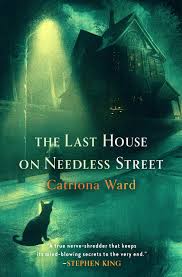
The Last House on Needless Street by Catriona Ward (Nightfire, 2021)
Review by Warner Holme: Catriona Ward’s The Last House on Needless Street represents an interesting variation on the psychological horror story. There are a few viewpoints, interesting ones, as well as an increasing fear as various alarming details are slowly piled atop one another to paint an increasingly disturbing picture.
One of the main viewpoints, and first really sympathetic ones, is Olivia. Olivia is a cat with a fairly strong Christian faith who thinks of every human she encounters as one type of “ted” or another. It is very much the mental image which could be put forth of a cat in a certain type of person.
One ostensible human lead is then known as Ted. The similarity in name to the way Olivia looks at people is no surprise to the reader, as she is the owner who lives in his house. At the same time the chances seemed high that something is desperately wrong with him. There are moments he seems to see a therapist of some sort, and at one point complains that his cat (Olivia) might be gay. He fails to feel pain when he should, and keeps first his cat and then a child indoors against their will.
The child in question is Lauren, a girl who seems to be in the strange position, of finding the situation weird and disturbing, while at the same time having acclimated to it more than a little. It is a strange point of view, yet quite disturbing in its way for the mixture of Stockholm syndrome symptoms and outright terrified moments.
There is also Dee. Dee is a relatively developed woman who suspects Ted of kidnapping her little sister. This is a very delicate line, and the fact that she doesn’t get much help from the police lends understanding to her actions as she moves into Ted’s life in an effort to find her sister.
These and other viewpoints steadily rotate, often repeating the same scene with subtle differences to illustrate the strangeness of the situation. The attempts by Ted to hide a host of details about himself, and the attempts of Dee and Olivia to understand their situations and improve them or right wrongs, each serve to advance respective narratives while moving the overall story forward.
Following the narrative, afterward, and acknowledgements, the author is good enough to include a bibliography of useful topics related to the bulk of the story. This is, under the circumstances, greatly appreciated. There is, of course, the risk that this material will become dated as research methods evolve and so does knowledge of certain psychological phenomena. It nonetheless speaks well to her that she took the time to research and consider the topic so carefully in writing this piece.
Overall The Last House on Needless Street is a strange and disturbing read. There is, as is often the case, a risk that the psychology in it will become dated, however that cannot be held against a current work which is clearly trying to stay up and accurate. The chills and disgusting moments are quite visceral, and even if a reader successfully determines the nature of some of the biggest “twists” in the book, it remains a cleverly constructed and thought-out piece.
Discover more from File 770
Subscribe to get the latest posts to your email.
